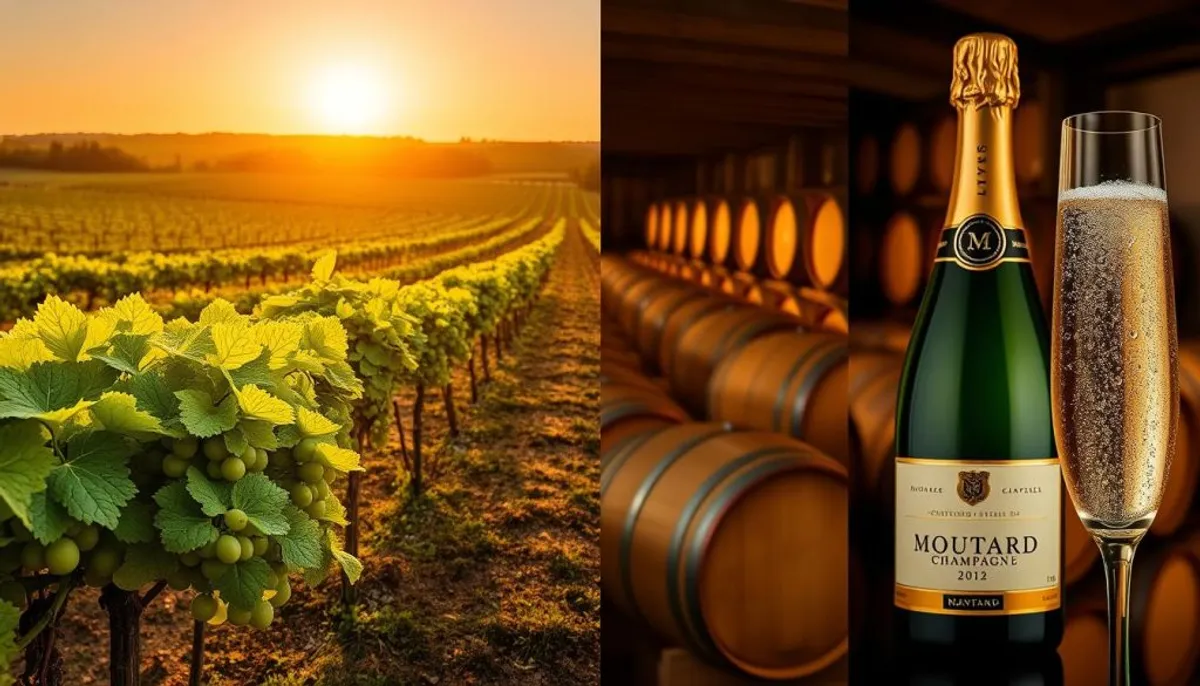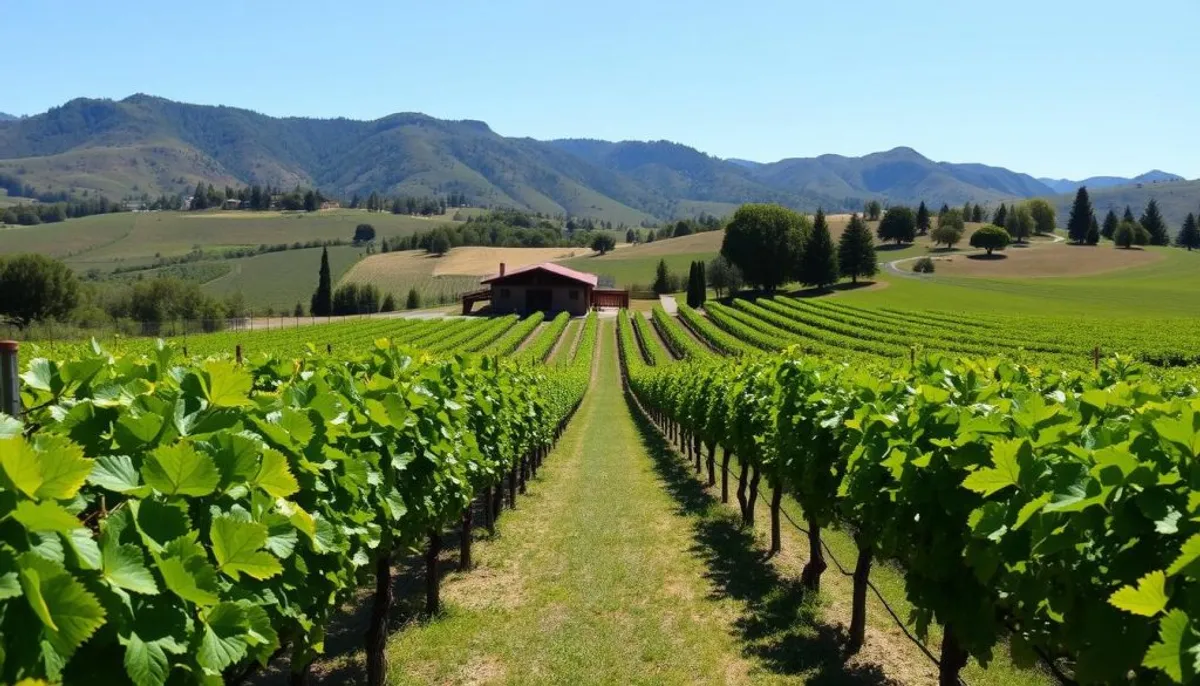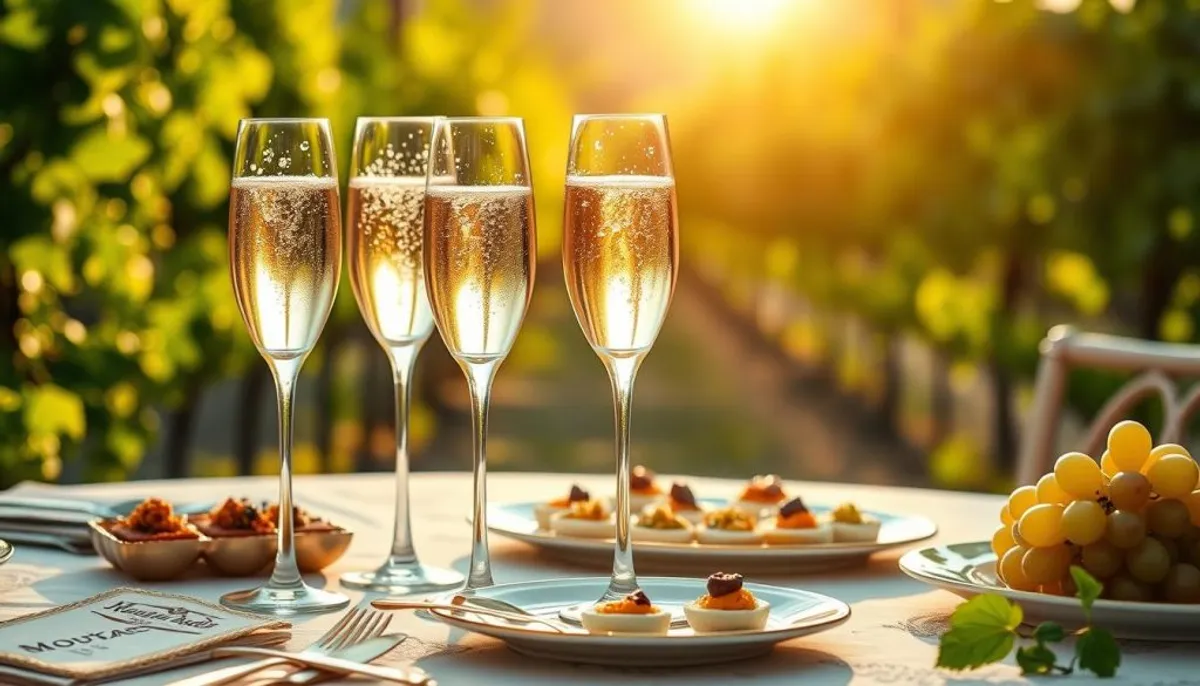Enter the realm of Moutard Champagne, where tradition harmonizes with innovation in each bottle. Founded in 1642, this French Champagne house has been perfecting luxury sparkling wine since Lucien Moutard planted his first vines in 1952. Today, Moutard Champagne exemplifies artisanal Champagne production, merging ancient techniques with contemporary winemaking prowess.

Moutard’s offerings span from the rare Arbane grape to the exquisite Champagne Blanc de Blancs, showcasing the family’s unwavering commitment to quality. Each bottle of this luxury sparkling wine narrates a tale of passion, craftsmanship, and the distinct terroir of the Champagne region.
Indulge in the limited edition Moutard Richardot Pinot Noir Vieilles Vignes or pair the Champagne Rosé Brut with delicate seafood. Moutard Champagne guarantees an unmatched tasting experience. Learn why aficionados globally seek this artisanal Champagne for its elegance and distinct character.
Key Takeaways
- Moutard Champagne boasts a rich family history dating back to 1642
- The house produces unique varieties like 100% Chardonnay and 100% Pinot Noir champagnes
- Limited edition vintages showcase Moutard’s commitment to excellence
- Moutard offers a range of styles, from brut to mild champagnes
- Proper serving temperature and glassware enhance the tasting experience
The Legacy of Lucien Moutard Since 1952
The Moutard family’s journey in Champagne history began in 1952 when Lucien Moutard established their family-owned winery. This marked the start of a legacy deeply rooted in the art of Champagne production.
A Family’s Dedication to Champagne Making
For over seven decades, the Moutard family has dedicated themselves to crafting exceptional Champagne. Their commitment to quality is evident in every bottle they produce. Unlike larger vineyards, Moutard’s modest 1,200-hectare estate allows for meticulous attention to detail in their Champagne production process.
Preserving Traditional Craftsmanship
Moutard Champagne stands out for its adherence to traditional methods. They employ non-interventionist winemaking techniques, using minimal sulfur and allowing their wines to age naturally. This approach, similar to renowned producers like Sorelle de Nicola Feyles, results in Champagnes with exceptional depth and character, including the notable jacques selosse initial.
The Evolution of Excellence
Over the years, Moutard has evolved while staying true to their roots. They’ve expanded their focus to include single “cru” Champagnes and organically farmed options. Like the Gavi DOCG, which represents a step up in quality from standard DOC wines, Moutard consistently aims to elevate their Champagne production standards.
The Moutard legacy continues to thrive, blending time-honored traditions with innovative approaches to create Champagnes that truly embody the spirit of their family-owned winery.
Discovering Moutard Champagne’s Unique Heritage
The Moutard estate’s storied wine heritage traces back to 1642, when their ancestors first planted vines in the Champagne region. This profound connection to the Champagne terroir has profoundly influenced their winemaking philosophy for centuries.
In 1927, François Moutard embarked on a pioneering venture by establishing his own champagne house. Beginning with a modest 1.5 hectares, he set the stage for a flourishing family enterprise. Today, the Moutard estate spans an impressive 23 hectares in Champagne and 40 hectares in Burgundy.
The family’s unwavering dedication to preserving rare grape varieties distinguishes them in the Champagne region. They cultivate not only the classic Pinot Noir and Chardonnay but also unique varieties like Pinot Blanc, Arbane, and Petit Meslier. This diverse selection imbues Moutard Champagne with its distinctive character.
| Year | Milestone |
|---|---|
| 1642 | Moutard ancestors plant first vines |
| 1927 | François Moutard establishes champagne house |
| 2002 | Moutard estate expands to 22.5 hectares |
| 2015 | Moutard Distillery receives Ecocert label |
The Moutard family’s commitment to quality transcends their vineyards. Their distillery, equipped with five copper pot stills, produces 170,000 bottles of spirits annually. In 2015, it earned the Ecocert label, acknowledging their dedication to sustainable and organic production methods.
This fusion of tradition and innovation, deeply rooted in the Champagne region’s rich history, encapsulates the unique heritage of Moutard Champagne. It serves as a testament to the family’s enduring passion for crafting exceptional wines that embody their terroir and expertise.
The Art of Production at Moutard Estate
The Moutard Estate stands as a paragon of excellence in Champagne production. It is distinguished by its meticulous vineyard management and innovative winemaking techniques. Their dedication to quality control ensures that every bottle adheres to the highest standards.
Vineyard Management and Terroir
The Moutard family’s vineyard spans 23 hectares, showcasing a diverse range of grape varieties. Pinot Noir dominates with 13.91 hectares, while Chardonnay covers 5.72 hectares. The estate also cultivates rare varieties like Petit Meslier and Arbane, adding unique character to their wines.

Winemaking Techniques
Moutard’s winemaking process combines tradition with innovation. Wines age predominantly in Burgundian oak barrels, with some bottles resting for over 15 years. This patient approach results in champagnes with distinctive flavor profiles, such as their special Arbane cuvée with notes of hawthorn and wild peach.
Quality Control Standards
Rigorous quality control is paramount at Moutard Estate. From pre-pruning to precise pruning techniques, every step of the vineyard management process is carefully monitored. This attention to detail extends to the winemaking process, ensuring each bottle of Moutard Champagne meets their exacting standards.
| Grape Variety | Hectares | Characteristics |
|---|---|---|
| Pinot Noir | 13.91 | Major variety in Côte des Bar |
| Chardonnay | 5.72 | Used in blends and blanc de vins |
| Pinot Blanc | 0.22 | Adds freshness to blends |
| Petit Meslier | 1.11 | Rare variety, unique character |
| Arbane | 1.28 | Special cuvée with distinct notes |
Rare Grape Varieties: The Petit Meslier Story
Champagne aficionados, get ready for an extraordinary tasting journey! Beyond the dominance of the three main grapes, rare varieties like Petit Meslier offer a refreshing viewpoint. Occupying a mere four hectares, this hidden treasure is cultivated by Moutard Champagne on 1.11 hectares. Additionally, the use of champagne yarn in the production process adds a unique texture to the final product.
Understanding Petit Meslier’s Unique Character
Petit Meslier distinguishes itself among rare grape varieties with its high acidity and frost resistance. These attributes make it invaluable in Champagne’s demanding climate. With only 20 hectares planted in France, Petit Meslier adds a unique dimension to select cuvées.
Tasting Notes and Aromatics
A tasting of Petit Meslier reveals a pale gold hue with green undertones. The wine features light, creamy bubbles and a distinct flavor profile. Expect refreshing mint, citrus, and green tea notes, offering an unforgettable sensory journey.
Pairing Suggestions
Petit Meslier Champagne excels in food pairing and is among our fine dining picks. Its crisp acidity and delicate flavors pair wonderfully with seafood. Try it with fish starters or a variety of cheeses for a culinary exploration.
| Grape Variety | Hectares in Champagne | Key Characteristics |
|---|---|---|
| Petit Meslier | 4 | High acidity, frost resistant |
| Arbane | 1.28 (Moutard) | Late-ripening, high acidity |
| Pinot Blanc | 0.5 (Pierre Gerbais) | Floral profile, racy acidity |
Victor Moutard: A Global Wine Journey
Victor Moutard exemplifies the essence of international winemaking. His odyssey across continents has merged traditional wisdom with contemporary insights. This confluence of experiences has profoundly influenced his craft, enhancing the Moutard legacy.
Victor’s educational journey took him to esteemed regions. He refined his skills in Châteauneuf du Pape and Chablis, expanding his grasp of French winemaking. His quest for knowledge extended to California, where he delved into New World methodologies.
The allure of the Southern Hemisphere drew Victor to New Zealand and South Africa. These destinations introduced him to innovative approaches and rich terroirs, broadening his expertise. Tasmania’s unique cool climate viticulture further enriched his global wine experience.
| Region | Focus | Impact on Moutard |
|---|---|---|
| Châteauneuf du Pape | Traditional blending | Enhanced complexity in cuvées |
| Chablis | Chardonnay mastery | Refined white wine production |
| California | Modern techniques | Innovative fermentation methods |
| New Zealand | Sustainable practices | Eco-friendly vineyard management |
| South Africa | Diverse varietals | Experimentation with rare grapes |
| Tasmania | Cool climate viticulture | Improved acidity balance |
Victor’s global odyssey has been pivotal in Moutard’s evolution. His experiences drive innovation at the family estate, elevating their wines to unprecedented levels. This synergy of tradition and global perspective ensures Moutard’s sustained success in the dynamic world of wine.
Sensory Experience: Tasting Moutard Champagne
Moutard Champagne invites wine aficionados on a journey of discovery, showcasing its distinct qualities through tasting. This journey delves into the captivating realm of this exquisite beverage.
Visual Characteristics
Moutard Champagne boasts a captivating pale gold hue with a green shimmer. Fine, creamy bubbles gracefully dance in the glass, signaling the quality within. This visual spectacle prepares the palate for an unforgettable tasting experience.

Aromatic Profile
The wine’s aromatic profile is a harmonious blend of scents. Fresh citrus fruits and delicate white flowers create an inviting bouquet. A subtle green tea note adds depth, enticing the taster to savor the first sip.
Palate and Finish
The palate of Moutard Champagne is greeted with a fleshy and silky texture. Spearmint flavor notes refresh the taste buds, offering a unique twist. The finish is fine and long, leaving a lasting impression of elegance and refinement.
| Tasting Element | Description |
|---|---|
| Color | Pale gold with green shimmer |
| Bubbles | Light and creamy |
| Aroma | Citrus, white flowers, green tea |
| Texture | Fleshy and silky |
| Taste | Spearmint notes |
| Finish | Fine and long-lasting |
Moutard Champagne’s wine characteristics harmonize flavors and textures. This sensory journey highlights the craftsmanship and dedication in each bottle. It is a true delight for Champagne connoisseurs.
Global Distribution and Accessibility
Moutard Champagne has broadened its horizons, making its exquisite bottles accessible globally through Champagne export. Wine aficionados can now indulge in these fine bubbles, regardless of their location. This is thanks to the efficient global distribution networks that Moutard has established. Additionally, for those looking to elevate their celebrations, creating stunning diy champagne walls can add a touch of elegance to any event.
Export Markets
The international shipping of Moutard Champagne has seen a notable increase. Key markets include North America, Asia, and Europe. The brand’s dedication to quality has propelled its popularity, rivaling the most renowned Champagne houses.
Ordering Process
Ordering Champagne from Moutard is straightforward. Customers can place orders through the official website or authorized distributors. The process is designed to be seamless, from selection to checkout.
Shipping Information
Moutard ensures meticulous packaging and shipping of their Champagne. They collaborate with dependable courier services to guarantee safe delivery. Shipping times differ based on destination, but customers can track their orders online for reassurance.
| Region | Shipping Time | Popular Products |
|---|---|---|
| North America | 7-10 days | Côtillon des Dames 2015 |
| Europe | 3-5 days | Priorat “Classic” |
| Asia | 10-14 days | Intergalactic |
Moutard’s adept global distribution system allows wine enthusiasts to enjoy their preferred Champagne anywhere. The brand’s commitment to accessibility ensures that the pleasure of Moutard Champagne can be shared worldwide.
The Terraces Salon Experience
The Terraces Salon at Moutard estate presents a distinctive Champagne experience for aficionados. It invites visitors to dive into the Moutard family’s storied past, while indulging in their premier cuvées. This blend of heritage and enjoyment makes it a pivotal stop for those exploring wine tourism.
On a visit to Moutard estate, guests can wander through the vineyard and gain insights into winemaking. The Terraces Salon is the perfect venue for Champagne tasting, offering a variety of Moutard’s finest vintages. Each glass recounts tales of tradition and innovation, showcasing the family’s unwavering commitment to producing exceptional Champagne.
| Experience | Duration | Inclusions |
|---|---|---|
| Estate Tour | 1 hour | Vineyard walk, cellar visit |
| Tasting Session | 45 minutes | 3 Champagne selections |
| Terraces Salon | 2 hours | Guided tasting, food pairings |
The Terraces Salon experience is tailored for both newcomers and seasoned enthusiasts. Expert staff lead the tasting, spotlighting the distinct qualities of each Champagne. This close environment fosters an opportunity for guests to engage in dialogue, enhancing their comprehension of Moutard’s winemaking artistry.
For those in pursuit of a memorable Champagne adventure, the Terraces Salon at Moutard estate offers a voyage through flavors, scents, and history. It stands as a crucial destination for anyone venturing into the Champagne region, delivering a taste of excellence in every sip, perfect for elegant celebrations.
Conclusion
Moutard Champagne represents the pinnacle of artisanal Champagne, seamlessly merging tradition with innovation. This luxury sparkling wine producer, including the esteemed piper heidsieck champagne, has distinguished itself in the competitive Champagne market. It offers a unique taste experience that honors its rich heritage.
The Moutard family’s unwavering commitment to quality is evident in their selection of rare grape varieties, including Petit Meslier. Alongside the traditional Chardonnay, Pinot Noir, and Pinot Meunier, they showcase a dedication to preserving Champagne’s heritage. This approach, combined with modern techniques, sets their cuvées apart in the global market.
Every stage of the Moutard Champagne process reflects their quality. The family’s global outlook, paired with their deep roots in the Champagne region, enables them to craft wines that resonate with connoisseurs worldwide. These wines remain true to their terroir, showcasing the essence of the region.
Our exploration of the Moutard journey reveals a legacy since 1952 and a current global presence. It’s evident that Moutard offers more than just a glass of bubbles. They provide a taste of excellence, a sip of history, and a toast to Champagne’s future.
RelatedRelated articles



